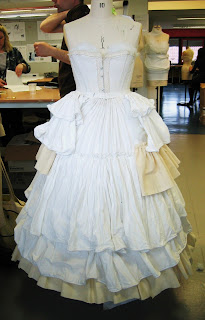This pattern for a muslin dress I have take from Janet Arnold's Patterns of Fashion 1. It represents quite an iconic shape of the 19th century for me and I am excited to start making it. I am going to start by draping the lining of the bodice and flat drafting the skirt and under-sleeve. On top of these I shall add the muslin layers in which the decorative elements of pleating comes in to almost every area of the dress.
I was pleased with finding this crinoline and feel it is a very appropriate shape for the period. It sits quite low at the back but this can be improved on with the adding of extra undergarments. As a basic under structure I think it is a good width and has the appropriate sort of volume I wanted for this toile.
The second stage of constructing the correct silhouette for my toile was adding the flounced petticoat and then adding extra calico flounces and padding underneath the existing ones to make it perfect. The images here are after I completed my alterations to the shape, I concentrated on rounding off the hips more to help the cartridge pleats of the skirt stick out. The extra flounces were for volume but also to create a more even shape down the shirt and to soften the bottom of the crinoline that was showing beneath the petticoat.
I was very happy with the resulting work of padding out the undergarments, especially as it took roughly a whole day in the studio to complete. It was quite a labouring process but the final result and the shape it will create for my draping was worth it.






Hello! congratulatiosn for your work!
ReplyDeleteI'm trying to make the exactly same dress, but I don't undertand the scale she (the author) use in the patterns, can you tell me the mesurements of it? Or explain me how to interpret the mesurements? Thanks a lot!